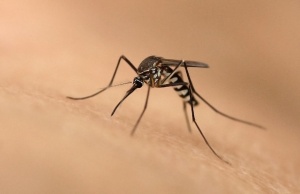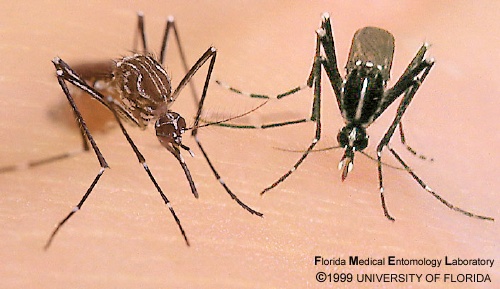Chikungunya Fever: Difference between revisions
No edit summary |
No edit summary |
||
| Line 20: | Line 20: | ||
<br>[[Image:Aedes mosquitos.jpg|center]] | <br>[[Image:Aedes mosquitos.jpg|center]] | ||
== Risk Factors | == Risk Factors <br> == | ||
*There has been increased prevalence in densely populated, urbanized areas, since humans are the only reservoir of the virus. | *There has been increased prevalence in densely populated, urbanized areas, since humans are the only reservoir of the virus. | ||
*Poor living conditions and maintenance of peridomestic environment including pooling of water in water recipients or tyres and inappropriate waste disposal.These are all sources of Aedes mosquito species.<ref name="Sissoko">Sissoko D, Moendandze A, Malvy D, Giry C, Ezzedine K, Solet J et al. Seroprevalence and Risk Factors of Chikungunya Virus Infection in Mayotte, Indian Ocean, 2005-2006: A Population-Based Survey. PLoS ONE. 2008;3(8):e3066.</ref> | *Poor living conditions and maintenance of peridomestic environment including pooling of water in water recipients or tyres and inappropriate waste disposal.These are all sources of Aedes mosquito species.<ref name="Sissoko">Sissoko D, Moendandze A, Malvy D, Giry C, Ezzedine K, Solet J et al. Seroprevalence and Risk Factors of Chikungunya Virus Infection in Mayotte, Indian Ocean, 2005-2006: A Population-Based Survey. PLoS ONE. 2008;3(8):e3066.</ref> | ||
*Migration and Travelling; the CDC estimated approximately 9 million people travel between the United States and the Caribbean each year, increasing the risk of transmission <ref | *Migration and Travelling; the CDC estimated approximately 9 million people travel between the United States and the Caribbean each year, increasing the risk of transmission <ref name="cdc" /><br> | ||
== Recent Related Research (from [http://www.ncbi.nlm.nih.gov/pubmed/ Pubmed]) == | == Recent Related Research (from [http://www.ncbi.nlm.nih.gov/pubmed/ Pubmed]) == | ||
Revision as of 21:31, 1 July 2015
Original Editor - Your name will be added here if you created the original content for this page.
Top Contributors - Vanessa Rhule, Lucinda hampton, Evan Thomas, Rishika Babburu, WikiSysop and Kim Jackson
Chikungunya (CHIK-V) Fever
[edit | edit source]
- An acute febrile illness associated with polyarthralgias, caused by the infection of the arthropod-borne alpha-virus, Chikunguyna virus (CHIK-V).
- The virus is transmitted to humans primarily through the bite of an infected mosquito
- The term Chikungunya is derived from the Makinde word meaning “that which bends up” [1]
- The first discovery of the CHIK-V was in 1952 in Tanzania, Africa with the first outbreak noted in 1999 in Malaysia affecting 27 people [2].
- The virus re-emerged in 2004 in countries of the Indian Ocean and has since then, spread to new locations leading to millions of cases throughout countries globally.
Aetiology[edit | edit source]
- The Aedes Aegypti and Aedes Albopictus mosquitos are the main vectors of the virus.
- The human being becomes the reservoir of infection and transmitted from human to human via the infected mosquito.
- These mosquitos bite mainly in the daytime and are also known to transmit the dengue virus [3]
Risk Factors
[edit | edit source]
- There has been increased prevalence in densely populated, urbanized areas, since humans are the only reservoir of the virus.
- Poor living conditions and maintenance of peridomestic environment including pooling of water in water recipients or tyres and inappropriate waste disposal.These are all sources of Aedes mosquito species.[4]
- Migration and Travelling; the CDC estimated approximately 9 million people travel between the United States and the Caribbean each year, increasing the risk of transmission [3]
Recent Related Research (from Pubmed)[edit | edit source]
Extension:RSS -- Error: Not a valid URL: Feed goes here!!|charset=UTF-8|short|max=10
References[edit | edit source]
References will automatically be added here, see adding references tutorial.
- ↑ Staples J, Breiman R, Powers A. Chikungunya Fever: An Epidemiological Review of a Re‐Emerging Infectious Disease. Clinical Infectious Diseases. 2009;49(6):942-948.
- ↑ Selvaraj I. Chikungunya. Presentation presented at; New Delhi.
- ↑ 3.0 3.1 Cdc.gov. Chikungunya outbreak progresses in Caribbean, Central and South America| CDC Online Newsroom | CDC [Internet]. 2015 [cited 20 June 2015]. Available from: http://www.cdc.gov/media/releases/2014/p1106-chikungunya-outbreak.html
- ↑ Sissoko D, Moendandze A, Malvy D, Giry C, Ezzedine K, Solet J et al. Seroprevalence and Risk Factors of Chikungunya Virus Infection in Mayotte, Indian Ocean, 2005-2006: A Population-Based Survey. PLoS ONE. 2008;3(8):e3066.








